🏄♂️ Kitesurfing
Written Oct 22, 2022. (This is a draft.)
Table of Contents
Introduction
Kitesurfing (kiteboarding), is a water sport that combines elements of surfing, windsurfing, and paragliding. You use the wind to ride across the water and perform aerial tricks.
I've been kitesurfing for 10+ years now. There's nothing quite like the feeling. It's physically challenging and mentally.
The disciplines are varied.
It can be as much of this:
Than this:
And this:
The learning phase can be frustrating, but it's definitely worth it. Once you've mastered good kite control, you will enjoy the pure bliss and adrenaline of this incredible sport.
Progression with kitesurfing is infinite. When you think you've reached your limits, you've just unlocked the next phase.
We are still at a phase in the sport where every year, new tricks never been done before are landed.
The sea's only gifts are harsh blows and, occasionally, the chance to feel strong.
- Primo Levi
This handbook is a no-bullshit braindump of most of what I’ve learned in my 10 years of kiting.
It also contains a few of the good, bad and ugly stories that happened to me over the years.
Motivation
Part of the reason I wrote this is every summer we see more and more people on the water. To the point that certain spots become nearly unpracticable for anything else than back and forths.
Many riders:
- don’t know basic & unspoken rules at best annoying others, at worst putting themselves and others in danger.
- get ripped off buying expensive, inadapted gear.
- stop progressing after the basics, because of fear and comfort.
In truth I’ve been all that myself.
- When I started kiting in 2011, I got ripped buying expensive gear that I could have got much cheaper. Because I (and the previous owners) didn’t take good care of it I had some scary accidents.
- Then I was that reckless kid who would do dangerous stuff close to people. Let alone did I know the priority rules. A few times I tangled my lines with other people in Tarifa. Once, I was 50cm from colliding with a windsurfer on a jump landing. 2 times I knocked myself out trying kiteloops without any idea what the hell I was doing.
- Followed a multi year period where I settled into a comfort zone and barely learnt any new tricks or expended into other subdisciplines.
While I’ve been kiting for 10 years, my progression really stepped up in the last 3 years when I started setting objectives, traveling to new spots and forcing myself to push my limits.
Ready? Let’s start.
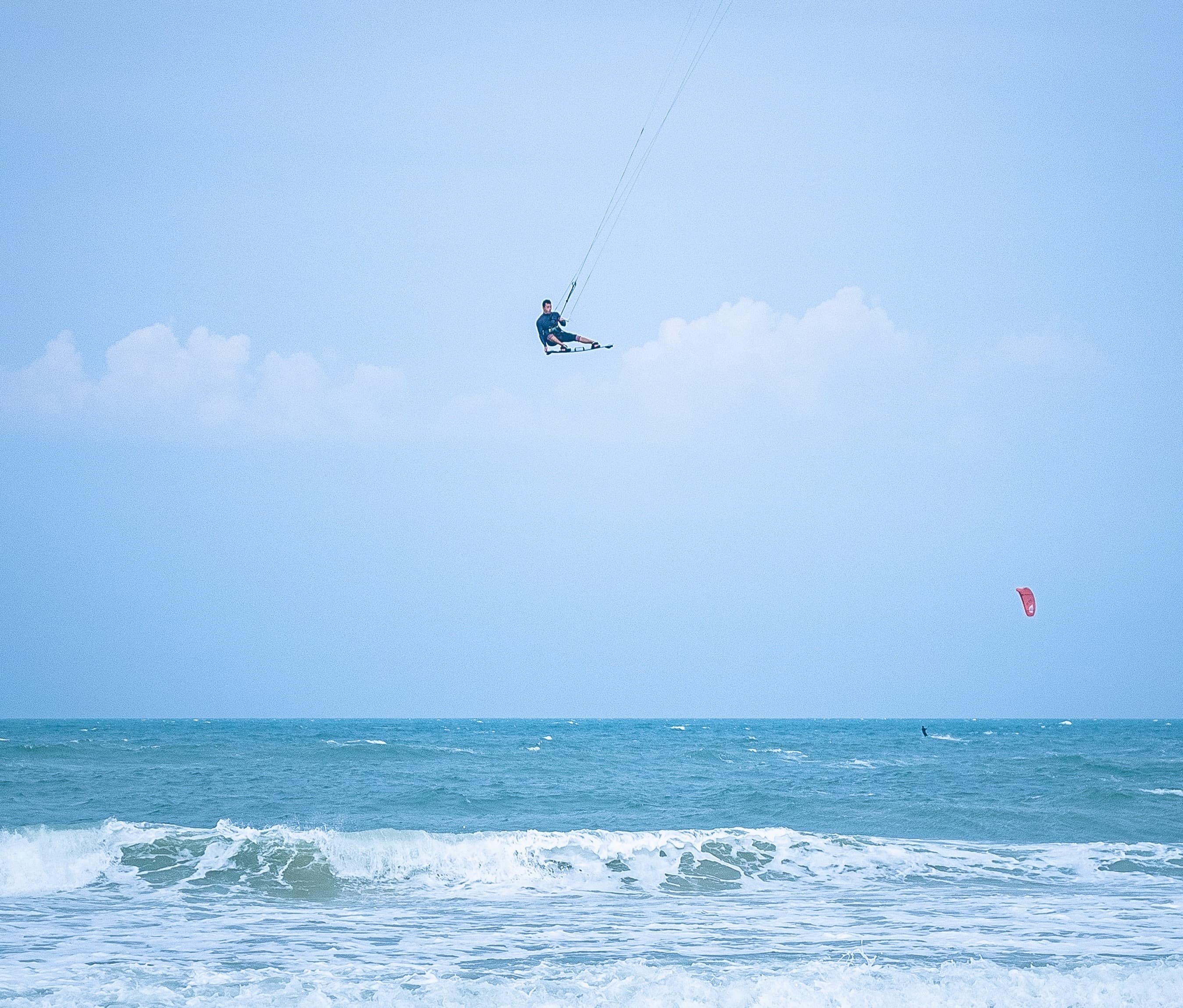
A good session in Brazil.
🐣 Beginners’ basics
👉 I won’t talk about very the basics as there is no way to skip the first practical lessons. You won't find mentions of waterstart, body drag, basic riding and going upwind steps.
Basic Vocabulary
- Twintip → Bidirectional board
- Strapless → Kiting on a surf-looking board, without straps
- Big Air → Discipline of doing tricks high in the air
- Unhooking → Doing tricks by removing the chicken loop from your harness, like wake boarding. Much more bar pressure.
- Off/on/side shore wind → Off = comes from the beach, side = perpendicular from the beach, on = from the ocean.
- Knots → Most common wind units used in watersports.
- Toe-side → riding with the toes pointing to the water
- Zenith → kite at 12o’clock in the wind window (right above you)
- Carving → sweeping turn by shifting your weight and shifting the edge of your board.
- Ejecting → triggering safety system over the chicken loop
- “It’s pumping” → strong wind mate
- Kicker → (or jump ramp) a wave or artificial structure used to take off in jumps
- Pop → a small jump created with the legs only (no kite movement) where you carve a little and go back downwind (TODO: pic)
- ROW → right of way
Wind forecasts
Checking forecasts ensure that you are going out at the right time.
Windguru is the most common place to look for wind forecasts. It has everything you need.
The most important rows are "Wind speed" and "Wind gusts". The delta between them is basically the "gustiness" of the wind. The lowest the better.
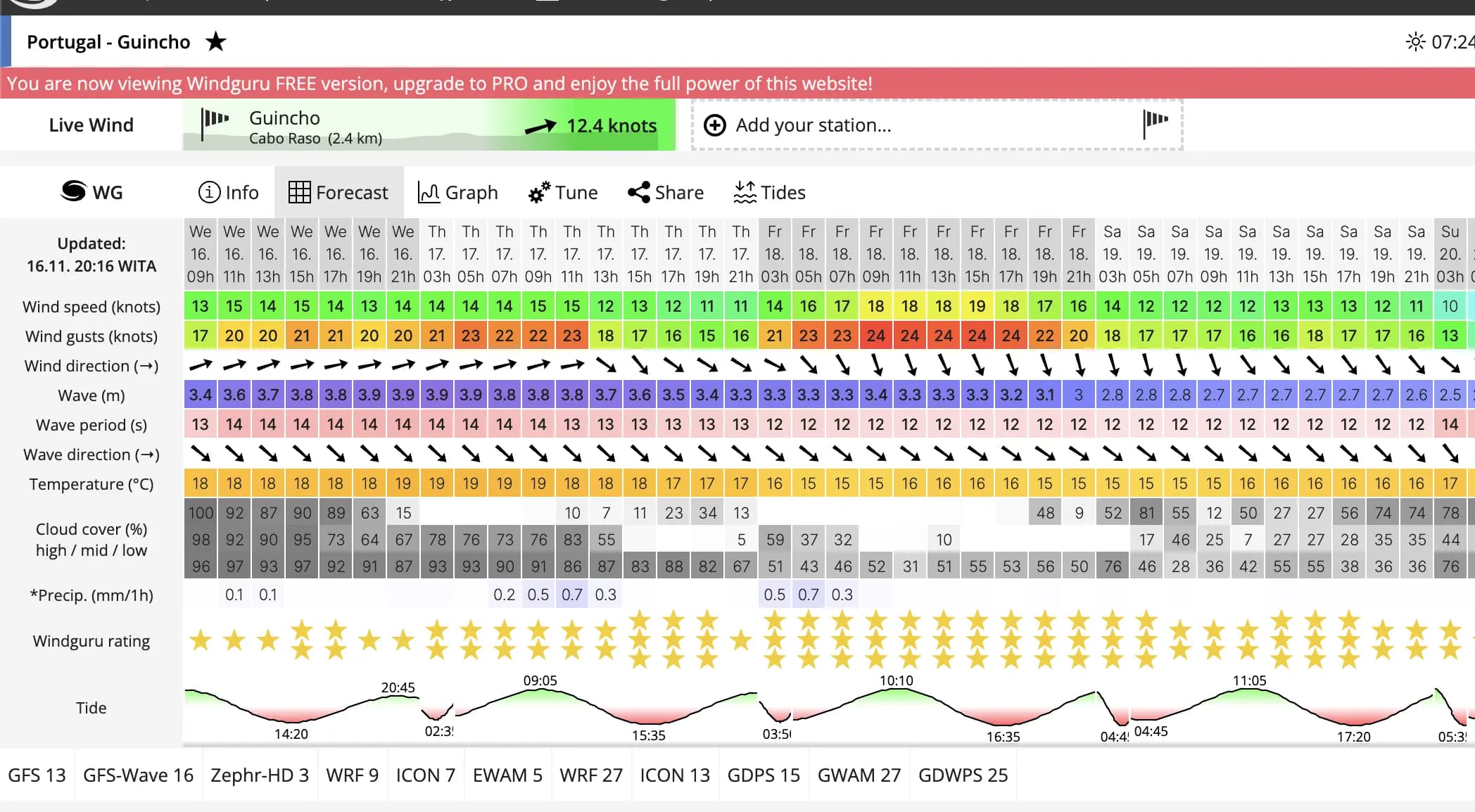
“GFS-13”, “ICON 7”, etc.. at the bottom are the different forecasting models. The number is the precision (in km). Usually lower number means more precise, but not always. Some models are better than others for some spots.
The “Windguru rating” is a good quick-glance info. 3 stars means it’s pumping, I’ll usually take the 7m and 9m with me. 1 star is a bit shit, but kitable. 2 stars is good for 12 usually.
The wave period refers to the time that elapses between successive peaks of a wave. It's typically measured in seconds, and is an important factor in determining the size and shape of a wave.
In general, longer periods are associated with cleaner, more powerful waves, while shorter wave periods are associated with smaller, more choppy waves.
Wind maps can be useful to understand the wind patterns across a region. A good tool for that is Windy.
If available, always check webcams before going out.
White caps on water means there's usually at least 14 knots. The stronger the wind, the more white caps.
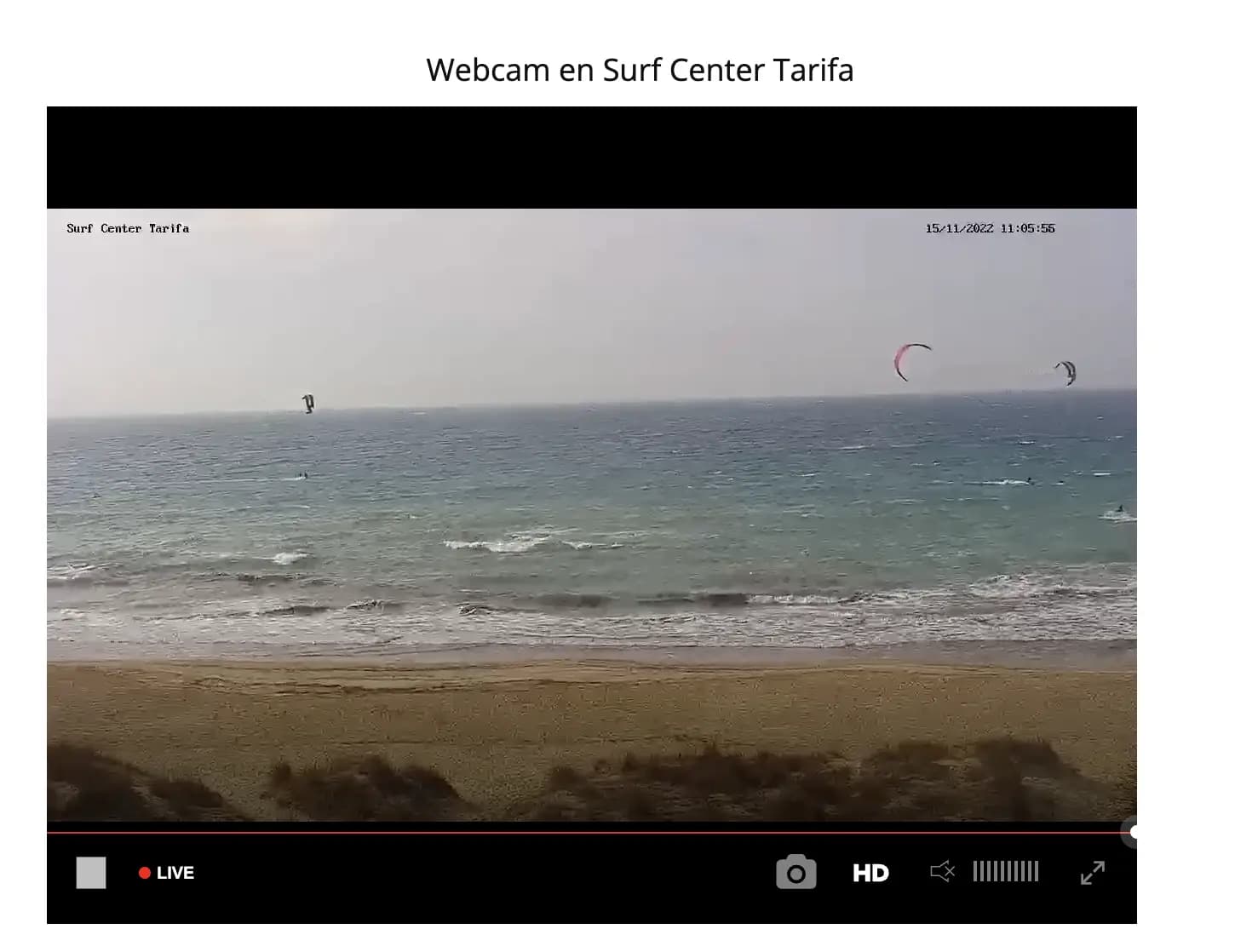
Webcams are often low rez. Here we can make out some white caps but not too much, meaning base wind is probably around ~14 knots.
In some spots, forecasts can be very inaccurate. Sometimes they are accurate with some wind direction and not others.
The golden rule here: it's always better to see with your eyes.
Oh and, you don’t need an anemometer. Learn to sense the wind and gauge it's strength from trees movements, the sand, the ocean and asking other riders.
Spot
Things that make a spot great when you're beginning:
A great spot is one that offers a combination of safe and accessible launch and landing areas, consistent and predictable wind patterns, and a friendly and welcoming community.
- Stable & frequent wind
- Friendly community of locals
- Flat water or calm ocean (neither big waves or strong currents)
- Where you can find: brazil, egypt, spain, portugal lagoas, vietnam.
If you never go in the ocean at the beginning, it’s going to be a surprise with you first meet a wave.
Overcrowded places suck in general, more people, more beginners, more danger. Good example: tarifa in summer.
Universal watersport rule: respect locals.
When you arrive in a new spot, be on the lookout for hazards:
- hidden rocks and sand banks
- strong currents
- dirty zones (rivermouths)
- wind dead zones (and power zones)
- prohibited zones
Ideally ask local riders directly.
Gear
Golden rule: It’s not about the gear it’s about the rider. A shitty rider on a good kite is still a shitty rider. A good rider on a shitty kite will be annoyed, but he’ll still be good.
You don’t need to change gear every year if you take care of it. Lines should be changed every couple of years as they are more susceptible to wear.
My first kite lasted me 6 years with a couple repairs.
Reasons for selling your gear every year:
- if you can get a good price on resell and not lose too much depreciation.
- when you get serious with big jumps or large waves you will want absolute trust in your gear, at which point it can make sense to want latest-year gear.
In terms of "features" or kite feeling, the truth is, year doesn’t matter much since 2014.
Less innovation more marketing. Except if you’re riding at a high level, you won’t feel the difference in the details.
What matters more is the quality of the materials, the shape of your kite and how you take care of it.
Choosing brands
Most kites come from the same 2-3 Chinese factories.
The quality and features difference is much less that what the kite makers' marketing departments want us to believe.
How you should select a brand:
- presence in your geography of retail and repair locations
- deals you can access
- personal feeling with the gear
👉 I personally love the feeling of the Fone Bandit kites, but had numerous quality issues with them over the years. If price wasn’t an issue I would buy only Duotone, as my Duotone gear never had issues.
Kite shapes
-
Generalist/hybrid/Delta: Evo, Bandit, Switchblade, etc. Best for beginners.
image not found
-
Wave kites: optimised for turning speed and more power at the edges of the wind window. Also good for beginners.
image not found
-
C-shape, bad for most people, especially beginners. For riders who like unhooking or looping. image not found
-
Special beginner kites: more resistant and forgetting but very frustrating when progressing because heavy & slow. Don’t buy.
-
Foil / non-inflatable kites: basically impossible to relaunch if they fall. But super you can go in super low wind and crazy jumps. Don’t buy that except if you know what you’re doing.
image not found
Bar
The bar consists of two parts: the control lines and the bar itself. The length of the bar can affect the handling of the kite.
In general, a short bar is better for performing tricks, as it allows for more control and precision over the kite. Shorter bar also give a more direct and immediate response from the kite, which results in faster turns.
On the other hand, a long bar can be better in strong winds, to have more leverage and control over the kite. A long bar can also provide a more comfortable and relaxed kitesurfing experience, as it allows the kitesurfer to keep a greater distance from the kite.
Some bars have adjustable ends so you can go from smaller to bigger.
I only have 1 bar for my whole quiver ()
With longer kite lines, you can generate more power and lift from the kite, which can allow to jump higher. On the other hand, with shorter lines, you have more control and precision over the kite, which can allow me for more precise maneuvers, faster turning speed and easier kiteloops.
It's often better/easier to get bar+kite from the same brand, but not necessary. Most brands today are compatible (you might only need to make a knot to adapt to the female/male ends).
There is two bar types: Y and V types. Today most are Vs.
Board
The more volume & size, the easier it will be to go upwind or ride in low-wind, but the less you can manoeuvre.
Tanks (big volumes) boards will suck as soon as you improve. Not recommended.
Longer board = less manoeuvrability. If you only go in strong wind, a smaller board is better.
👉 I started kiting at young with a 127cm board (very small). As I’m mostly riding in 25+ knots winds, I kept that board for 6 years without issue and still love using it.
Things to look for when buying a kite second-hand
- Valves abrasion
- Lines wear
- Holes in the fabric and repairs
// 👉 Story about bandit lines and valves>
Wetsuits
Today most wetsuits won’t last more than 3 years (if you know of a quality brand hit me up). The trick to making them last is to be extra gentle when taking them off, not apply pressure on the seams. This is the first things that break and then water gets it, and then you’re cold.
Getting discounts
Go shopping off-season or at the end of the year, when retailers are often looking to clear out older inventory. You'll be better able to negotiate.
Ask pro/sponsored/shop owners riders in your area for their previous years models (they change every year).
Best deals: find rich people cycling gear every year who don’t ride much (kites in good quality).
Don’t buy used gear from your kiteschool (yes they will try selling to you) as it will have gotten significant shocks and damage. Even if < 1 year old.
New fabrics SLS/Alula
→ TLDR they’re slightly better in the extremes of the wind range and turn faster. If you’re a beginner you won’t feel the difference.
Overpriced imho, don’t buy except if you’re rich or you can have a great deal. Wait a few years and prices will get lower.
image not found
Flying with gear
Clever Tricks to Fly with more Kitesurfing or Surfing Gear
Taking care of the gear
Taking good care of your gear will help it last longer.
- Rinse with fresh water after each use to remove salt, sand, and other debris. In priority your bar and harness. Ideally your kite too (lines and valves). Because of salt crystals that then dries and damages the materials.
- Minimise exposure to Sun / UVs and or the flying sand.
- Look for wore lines on kite before going out.
- Get yourself a bucket to remove your wetsuit: your wetsuit will stay clean, it makes it easier to carry it and you won’t step on it while over gravel or sand, damaging it.
General priority rules
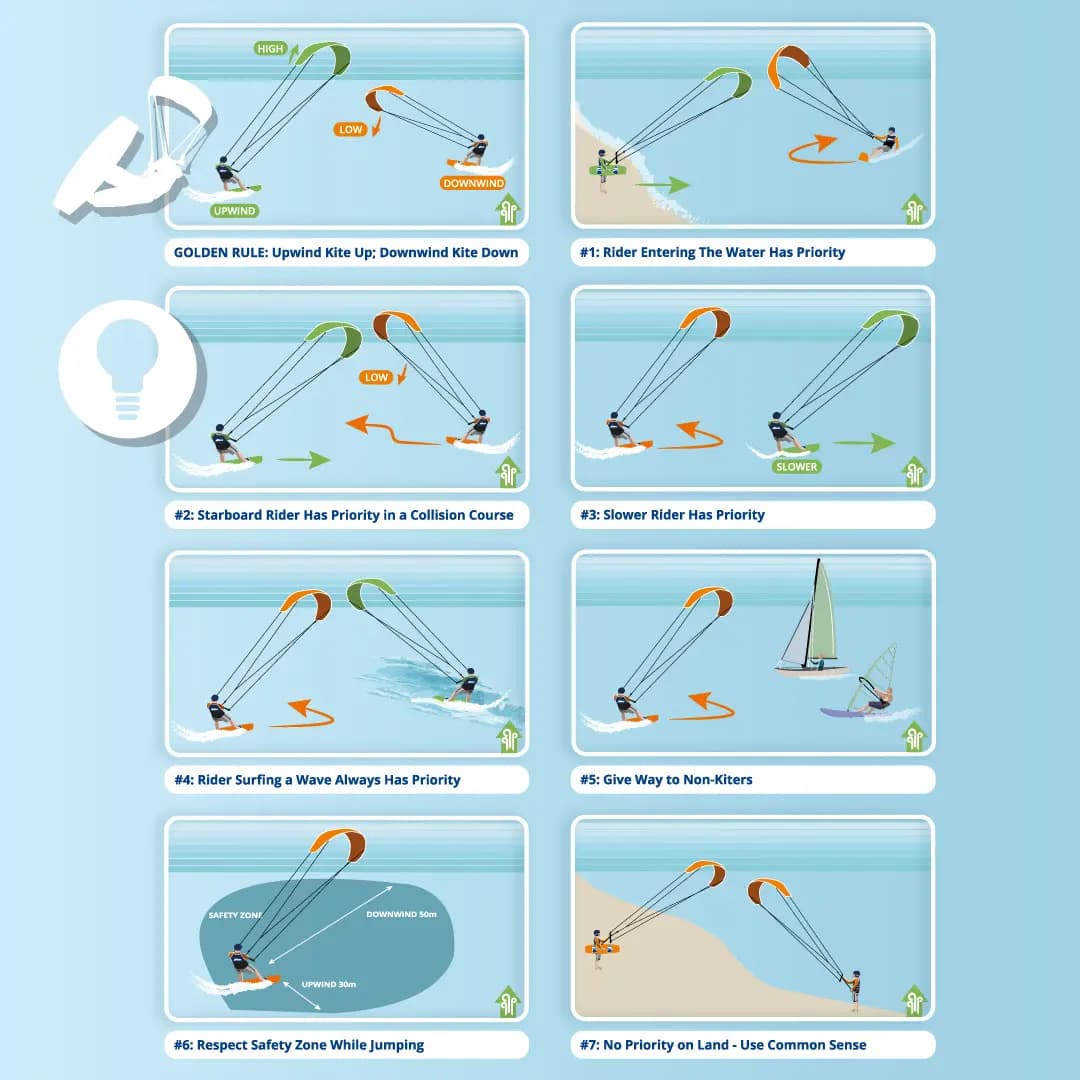
Unspoken rules
- Before turning / switching side, LOOK BEHIND YOU to make sure no-one is on collision course.
- Don’t stay in the water doing nothing with your kite at zenith, you risk stalling and block people from passing upwind from you.
- Respect locals even if they don’t perfectly respect all the rules. Especially in less popular spots.
- If you’re not confident, better to go where there is more space and less people.
- While beginners have priority (as lower mobility), try to be mindful and give space to more advanced riders. Will avoid angry faces and cursing.
- Freestyle: They often will jump closer to the beach or where the water is less choppy.
- Strapless: they’ll go upwind a lot then ride the wave down wind. Don’t cut them in the middle of the wave.
- Riders body-dragging, as for ones in trouble, have ROW
- Don’t launch/land your kite close to tourists and kids if you’re not 100% confident in your handling. If needed ask them with a smile to go a bit further away.
- Surfer can be very annoyed at kitesurfers, be mindful of them, don’t pass or jump close to them. It’ll piss them off. Don’t take their wave.
- Windsurfers can go super fast, so before you jump, be extra careful. Small reminder video:
- Be careful with windsurf masts. When a windsurf passes downwind, raise your kite.
Safety and preventing injuries
Do a warm up routine before your sessions to prevent 90% of soft injuries. Especially the neck and the back.
👉 Once in La Guajira, Colombia, I stumbled upon a crazy good, flat spot and rented a kite. I was so excited I didn't warm up and straight up jumped in the water. After a tough reception, I felt a light snap in my neck and didn't stop immediately. Waking up from my ensuing nap, I discovered I couldn't rotate my head anymore without terrible pain. The worse my yet to come: the 3h ride back to the city on an old jeep with dead suspensions. No roads: straight up dirt carnage dangling your head like a wobble. Left me with a terrible stiff neck for a few weeks.
Don’t wear boots (if you’re not hardcore wakestyling). You can get nasty injuries at your ankles & knees as when you crash your feets won’t leave the board. Ask any wakeboarder.
Never ever use a board leash, it’s very dangerous. You risk a board recoil. Nasty gnarly stuff. Even the reel leash stuff. Learn to body-drag effectively instead.
If you find yourself stranded at sea with your kite down:
- Swim to your kite to catch your breath. if wind is side/on-shore, use kite as a sail to come back.
- If lines are twisted, don’t try to relaunch and eject.
- If off-shore wind you get pulled out, if there is no rescue service abandon your gear and swim back. Hail someone if you don’t have the energy to swim back.
If tangle lines with someone else, usually eject.
Have a line cutter in your harness for really fucked up line tanglements.
Spend time on the beach just flying the kite to improve your handling and intuition. Learn to feel your kite position in the bar.
Prevent kite stalling: run back to restore line tension. Don’t leave your kite at zenith.
Oh and, never make your friends/family try your kite if you’re not a teacher. High probability of injury.
😎 Intermediary
Learning to crash
- Release your bar
- Once you start going a few meters up, not a dumb idea to wear an impact vest to protect ribs & back.
- Try not crashing head first (In my first years got 2 full knockouts because of that) or put your arms in protection.
- Landing on your butt > your back
- Release your board and try to throw it too far to land on it. I have a 5cm scar on my shin because I landed on my board once :(
- Fold your legs, if you’re like a stick you’ll plunge deep and might hit the floor
First jumps
- The basic formula of a jump is
jump = line tension * speed - Kite position: 10 to 12 to 10
- Try as many times as it takes, slowly first then with more speed
- Receptions
- Your board should be inclined 45 degrees toward the front
- Make sure you have enough water (landing feet first in the sand hurts like hell)
- Board position to minimise knee damage
- Then try your first backloops & frontloops (primitives). The trick is just to look where you want to go and to not use your bar to try to stabilize yourself, making unwanted kite movement.
Basic transitions
Basic jump transition
Toeside transition
Backloop transition
Having fun in waves
Waves are frustrating at the beginning when you don’t know how to handle them. They make you struggle to go upwind and lose your balance.
Once you master them, they become super fun. It adds a whole new dimension to the riding. It’s like a skatepark.
There are different ways to pass a wave:
- Small: absorb wave in your legs while trying not to move the body. Less upwind loss and keep speed.
- Pop: go above higher waves.
- Jump over: For bigger waves about to crash onto you
If you’re caught into a wave:
- At first pull bar to put tension in lines to try to pull yourself out. Make sure you don’t get wrapped into the lines. Nasty stuff. If so, safety release everything.
If your kite fall and gets caught in a wave (it will happen):
- See if you can relaunch before the next one. You’re lucky if you can.
- If the waves are not too strong: let the kite drag you while swimming toward the beach.
- Again, be super-careful not to get wrapped in lines.
- If lines wrap around the kite, make sure no tension in the lines or eject if risk so you kite doesn’t get wreckt.
- If big waves (> 3m), probably eject.
- As your kite arrives toward the beach, hail someone to immobilise it or as you set foot run toward it and block it.
Courtesy rules
- 1 jump each, except if you fall more. If you go in expert spot, like Balneario in Tarifa, give priority to better riders and be careful to not disturb them. They come here to train every day.
- If you’re only two going out and the other helps you launching, ask the other if he needs help launching, especially if gusty wind. If so, put your kite at zenith, hold his with one of your arm, and wait for the thumbs up.
- Keep an eye on fellow kiters. Help people recover their board if they fall far from it.
Improving posture
You can instantly tell from the posture of a rider what is general level and comfort is.
Things to work on to improve your posture:
- Stop looking at the kite (better for your eyes and neck). Look where you're heading.
- Stand straight on your board, don't sit in your harness
- Your harness should support your lower back, at the center of gravity of your body
- Hold your bar in the middle
- Relax your shoulder and leg muscles
| 👎 Bad posture | 😎 Good posture |
|---|---|
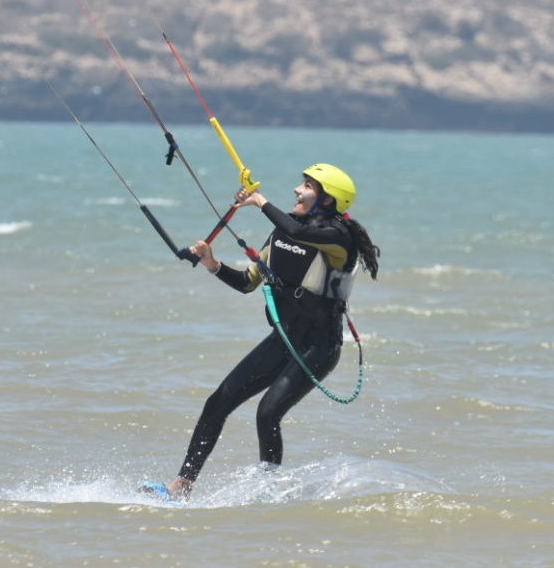 | 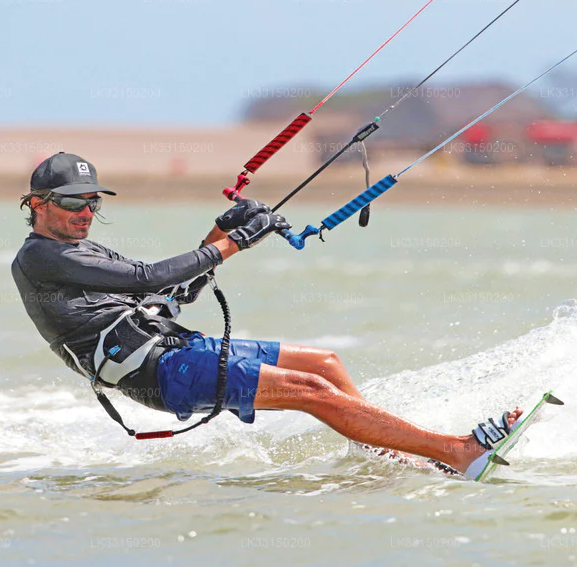 |
😮💨 Going next-level
Progress can be long and frustrating. Don’t give up and keep training, the resulting freedom and sensations are 100 times worth it.
Self launching and landing:
- Safely self launching
- Safe self-landing
- Easiest one: asking strangers.
- Line-pulling technique: usually the best but won’t work in strong wind. Bring your kite to the side of the window and pull hard on your middle lines. The kite should stall and fall on its front.
- Attaching to a pole: good if you can find a pole to attach your leash at.
Offshore riding and gusty winds
Common advice is that you avoid going out by off-shore wind.
That being said, I've had my best sessions with pumping 30knots offshore wind.
It crafts beautiful kickers on the waves and those are usually less crowded days.
Precautions to take:
- Do an extra check of your gear and your lines. You don't want anything to break as getting back your gear will be close to impossible.
- If there's no rescue service or you don’t know the spot: don’t go alone.
“Feel good” tricks
Darkslide
How-to:
- Do a soft pop off the water by carving a bit upwind
- Slowly steer your kite pas 12
- If you need more lift, steer faster
- Steer had for the downloop at the end of the slide

Backroll Kiteloop
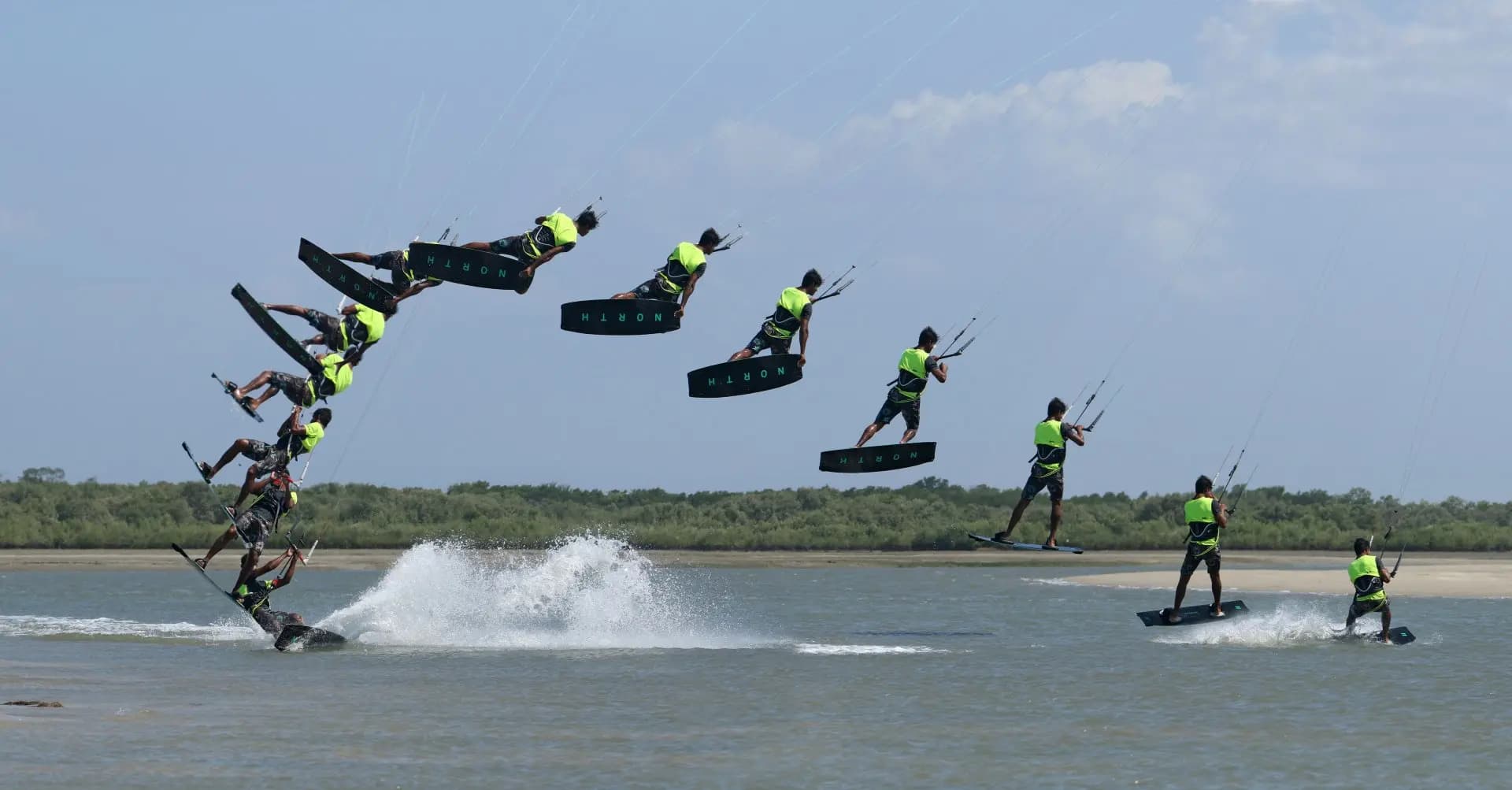
Hand drag

Inverted frontroll
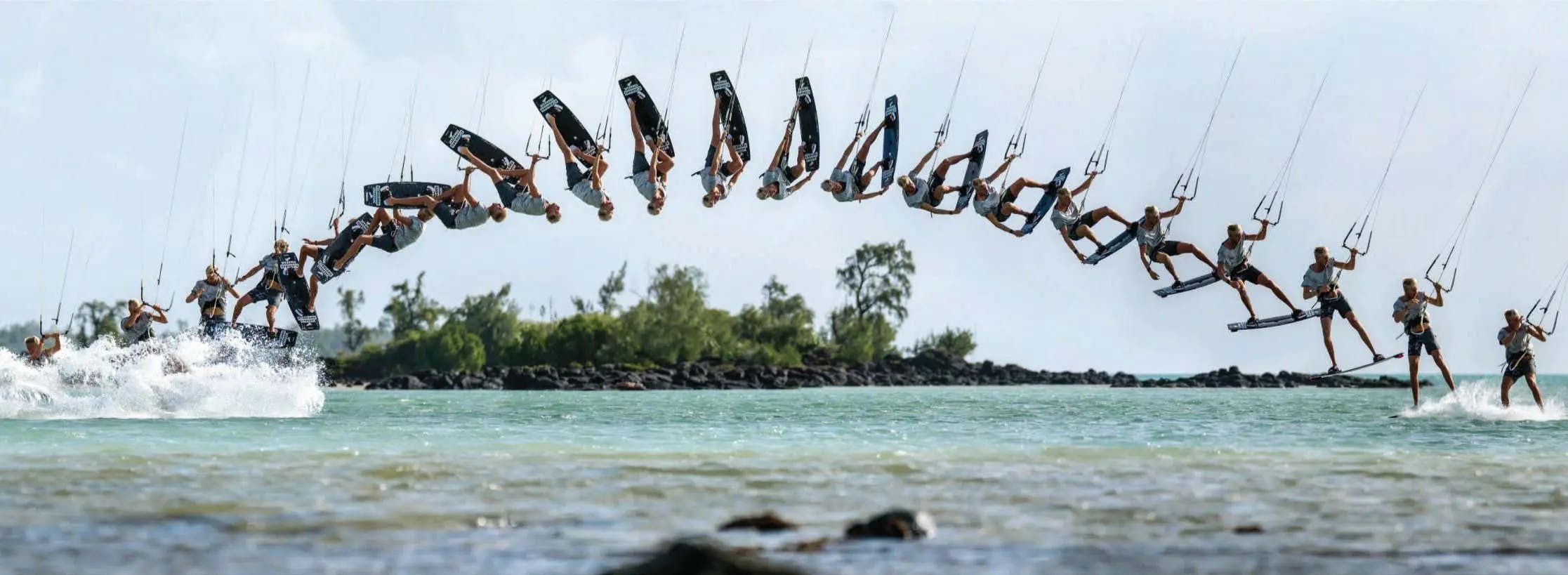
One of my personal favorite. The feeling of this one is so good I can't go on the water without a couple of those. Easily extendable with grabs and foot-offs, and aditional spins.
Board off
- Super fun, opens up many variations
- Open straps to easily get in/out. Train on a chair.
- Start with foot off.
- Need ~100 attempts to master.
- Next, try combining with front/back loop.
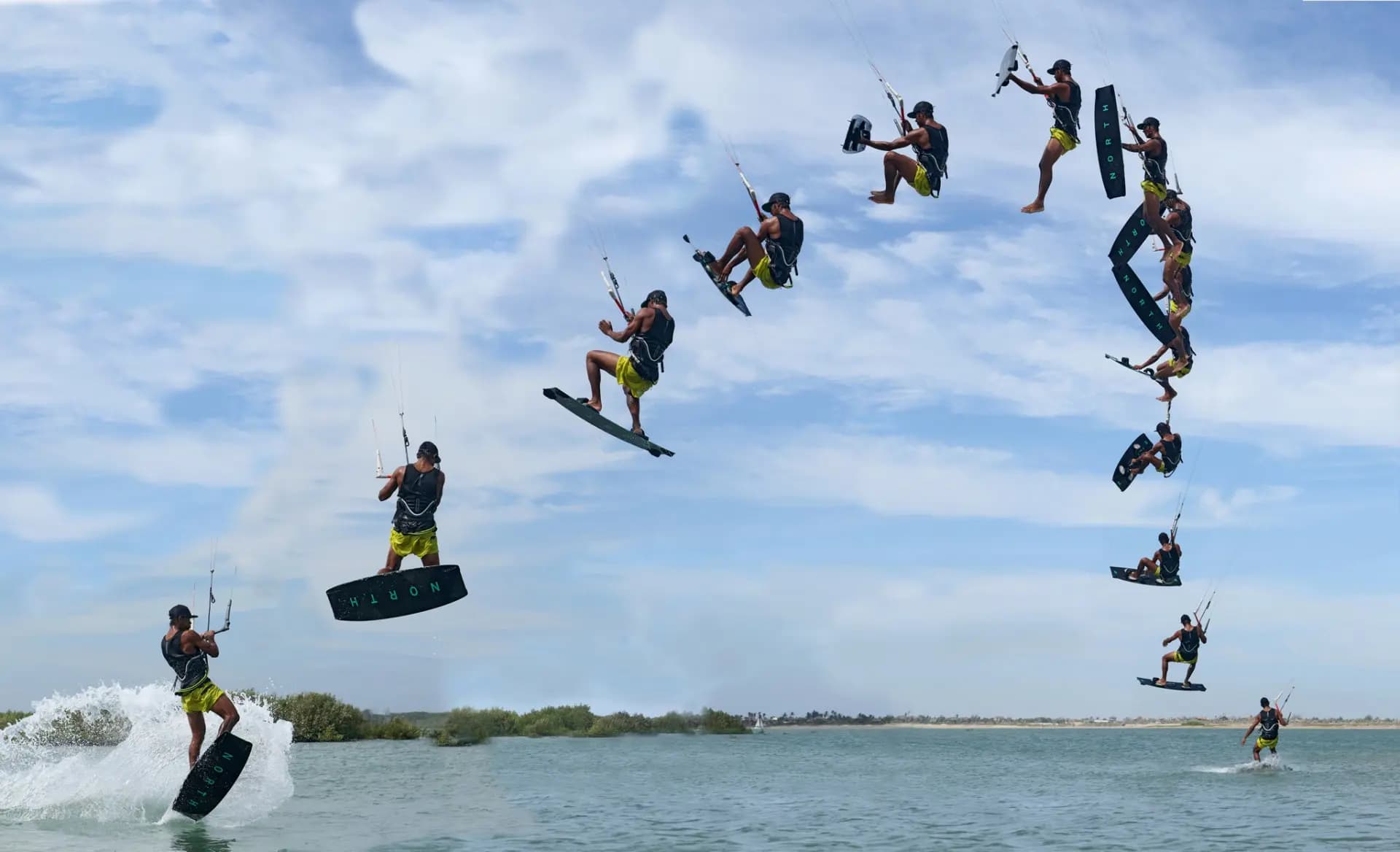
- Add grabs to tricks for style increase
Tips to learning tricks
- Non-looping tricks: learn on bigger kites: much more forgetful. You won’t accidentally loop your kite.
- Watch breakdown videos, visualise in your head. Each time you fail, try to see where you’re doing it wrong. Train your brain to go through it.
- Practice movement on the beach.
- Often problem is kite position, be mindful of it.
- Ask better riders. They’ll be very happy to offer advice and you socialise.
- Perfect the primitives and combine them:
- Grabs
- Backloop,
- Frontloop,
- Board-off
Downloops
Downloops are essential in going high, to smoothen your landing.
How to downloop: Move your kite to 1pm, then as you start falling down pull your bar the other side to make it loop over you.
Strapless
- Yes, you can start practicing with a normal surfboard. Less than 6’ ideally. It’s still fun.
- Same priority rules as surfing, don’t cut trajectories.
- Perfect direction for wave:
- Try jumping
🚀 Joining the airforce
Okay we’re finally getting to the meat of the beef. Shit’s starting to get realll fun.
Going highhh
How to maximize height:
- Go the fastest you can
- Carve strongly upwind
- A bit before taking off: do a pop to add extra line tension
- If you can: use a wave as your kicker, hit it at ~90deg angle from your direction.
- Move fast the kite to 12 while pulling the bar
Tip: With offshore wind conditions, the best flat water will be the closest to the beach.
Common error: sending the kite further than 12, at 2 or 3. To get maximal vertical thrust, you want the kite at 12.
- Perfect moving the kite position at 12
- Make sure enough space and no-one in trajectory.
Kiteloops
Kiteloops are intense. You are experiencing free fall and horizontal speed.
Golden rule of kiteloops: once you commit to a loop, go all the way. Starting a loop and aborting in the middle is fatal. I had 2 knockouts to learn that when I was younger and reckless. Knockouts are no joke.
- Start in constant wind
- Start with less than 10m kites and less than 24m lines. It'll turn easier.
- toilet position when it loops
- Make sure you jumped high enough, then pull the bar at the extreme.
- If you’re not high enough, the kite won’t have time catch you down and you’ll crush your knees.
- start doing vertical heli loops and 8s before real kiteloops
- some kites are easier to loop (I.e Dice) and more forgiving, but you can loop with any kite. Look at these guys looping the Rebel which is notoriously anything but a looping kite.
Top players to follow for inspiration
- Lorenzo Casati
- Mitu Monteiro
- Airton Cozzolino
- Liam Whialey
- Get High With Mike → best learning videos once you get to looping-level
Where to go from there
Well.. We’ve reached the current limits of my kiting, so I cannot really give you more tips. I will keep this updated as I learn more.
Now you can start combining the loops with the board off, inverted front rolls and other spins you’ve learned before. Or you might just feel like diving in another subdiscipline like wakestyling or strapless.